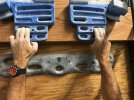Phil S
Level 1 Valued Member
Indeed - and it appears to be catching on among some climbing ilk.GTG Hangboarding.... It’s a good concept
(first post, longtime lurker - since the RKC days)
Indeed - and it appears to be catching on among some climbing ilk.GTG Hangboarding.... It’s a good concept
Question - what's the difference between using a suspended hangboard like this Lyons Edge and using a hangboard attached to a wall? Most seem to be attached. I imagine a suspended board would be harder, all other things being equal.GTG Hangboarding.... It’s a good concept


Thanks - that's why I no longer use them regularly.Eagle loops (and similar) can be very stressful on the finger joints
I can’t say enough good things (as people around here will attest to) about a pulley / counterweight set-up...@Steve Freides in my experience the suspended ones can be a little tricky for getting the front/back tilt to be consistently angled the same, set to set. Annoying when you're trying to do repeats on short rest.
Still - they're better than not - and i personally have a suspended edge i use formerly for gym trips when i want those deadlift hormonal gains to help out my fingers. Also useful as pictured on the website for use in the wild. Having a consistent edge is nice for warmup in the woods. Or camping trip training. Or visiting your inlaws etc. A KB and a hangboard is obviously pretty great for portability and keeping training momentum.
Fixed board is nice when you're adding load particularly - possibly swinging and intensely loaded delicate white tissues are a fraught combo. And just taking potential variables out of the scenario. If you're climbing then you've already got lots of variety in your hand and finger loading and so just want precise, repeatable circumstances for training and testing. Unloading also a factor - i have a pulley and counterweight system mounted under the fixed board for using grips that i can't or couldn't yet do with full bodyweight. I'm a newish climber middle aged and of undistinguished pedigree - and so half crimps on a 35mm edge with 24 and then 16kg taken off were instrumental in developing finger strength at those angles and catching up my digits to my general pulling strength.
This is the video that helped me a bunch.Do you have any gripper technique videos to recommend? I've been on the brink of bagging the #2 for a while - I can close it confidently for singles on the right but only about 60% of the time on the left. I'm sure my technique could be improved.
I could probably close it consistently if I adopted an easier narrow competition set, but since I only compete with myself, I'm not really interested in that.
Mike Prevost is quite the expert on this topic - Mike Prevost: Ruck Training Programs - PART 1 - On Target PublicationsRight. Hell, I'm not sure I even see that much carryover from running unloaded and on roads and trails to hiking weight perpendicular to contour. Maybe I catch my breath a little quicker on the flats or at the top of the hill, but the hiking still sucks. (Not to issue a recommendation against running, more a purely autobiographical note.).
Absolutely. I started climbing in summer 2017, 1-3x a week. Did my research, spent time on technique and built volume and intensity slowly.I can’t say enough good things (as people around here will attest to) about a pulley / counterweight set-up...
Often times people who have no conception of what ‘hard’ is; by any real definition of the word...I've never understood people who talk about orthodox weight training sessions, HIT cardio etc as if they are going to war.
1. Dress like Bridwell, Long and WestbayBonking, cramps, and the joys of Nose in A Day. What are your insights, experiences, preventions, solutions, sources, etc on these issues?
1. Look good
2. Have fun
3. Don't be gripped (1+2=3)
4. Safety third.1. Dress like Bridwell, Long and Westbay
2. Climb like Bridwell, Long, and Westbay,
3. Be Peter Croft
Seriously though...
Although I have only been to the Valley once ... My experience says less ‘dry-land’ training and more climbing
This time has nothing exceptional. Many runners (hundred?) run way faster for 1000m uphill. Look at the Vertical Kilometer races (VK).Here’s an ‘uphill tidbit’ for you all...
Back in the day... Reinhold Messner was able to run (claimed) 1000m uphill in 35min.
Yes I am well aware. But 40 years ago this was actually a pretty decent time; and by a person who was not a runner per se.This time has nothing exceptional. Many runners (hundred?) run way faster for 1000m uphill. Look at the Vertical Kilometer races (VK).
The best time in 1000m uphill run is 28min53s by Philip Goetsch. It was done in the famous Fully race (Switzerland): 1.9 km long / 1,000 m uphill. It's near the start of Sierre-Zinal, perhaps the most renowned mountain race in the world.
